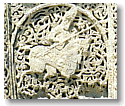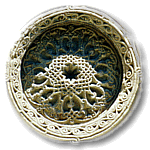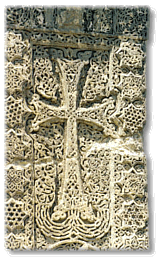This tour will take
about two and a half hours (3+ if you take time to look at everything in detail),
and is divided between the Complex (45 minutes), the Cathedral and Museum (60
minutes), and the Old Katoghikos Residence (45 minutes).
Most of the buildings and monuments inside the current complex were constructed from the mid 17th century forward, after Holy See returned to Echmiadzin. The complex is divided into three main courtyards: East (main entrance gate), Central (Cathedral) and West or Residential Quarter (New and Old Residences, Church Treasury). The entire complex is surrounded by tuf walls and the exteriors of several buildings.
Before entering the complex, you will find small stands selling everything from khachkars, paintings and jewelry crosses to refreshments and worry beads. The captive birds are meant for matagh, or sacrifice, and predominate on Sundays and major holy days. We had a friend who used to purchase one on each visit and set it free--seems there are no rules what you do with the animal once it is bought, as no wrath of God was poured on her head for doing so.
The outer buildings comprise the Observatory (1), uncompleted, a large park (2) and the new Main Gate (3) which leads up Tarkmanchats poghots past the Gevorkian Seminary (4) and the parking lot to the main complex.
The Eastern Entry (old main gate) (5) opens onto the East Courtyard and gardens, framed on the western side by the back of a 19th century Seminary Dormitory (10) and the 1771 T'paran (9) lie. At the time of writing a new guest house (8) was being built, to be used by church dignitaries and special guests. The book store (6) sells religious and souvenir books, maps and gift items, including a small introductory booklet to Echmiadzin in English, and a beautiful (though hefty) Treasures of Echmiadzin, priced at 50,000AMD. To your right as you continue is a fountain and the 1563 Sodk Khachkar (7) from Sevan region. The simplicity of the design and the choice of black basalt make a striking impression, especially when it appeared with hundreds of others on the wind-swept hills above Lake Sevan.
The sidewalk between the Old Dormitory and the 1771 T'paran, or Publishing House (9) leads to the tree-lined central courtyard. The walls on the old dormitory are pockmarked with rifle shots, and we have heard everything from fighting during the Persian era (not likely since the building is early 19th century) to fighting against Red Army invaders to explain this. It seems no one really knows, is wants to tell, as 50 visits later, the explanations get more interesting or faces more quizzical. Locals have a need to explain everything, even if uncertain (though the Persian explanation came from a western Armenian) , so you may find the answer, or you may just have to create your own myth.
An oasis in the hot summer months, the cool shadows and carefully tended central courtyard swarms with worshippers during major holidays. During the funeral for Vazgen I, the outpouring of mourners filled the entire complex and surrounding areas including Komitas Square. It is a large courtyard, divided into sections by carefully maintained flower beds and shrubs. If you've been huffing it through the tour so far, take time to rest on one of the benches and soak in the atmosphere. This is the center of the Armenian Apostolic Church, and the ground beneath you had witnessed more than 5000 years of history.
The church is the latest incarnation of temples going back to the Mid Bronze Age (uncovered) or to the late Stone Age (conjectured). Throughout Armenian history temples were built at the necropolis of settlements, so the immediate surrounding area would equate to the city of Quarlini, Vartkesavan and Vagharshapat. The Residential area is thought to lie where the King's Palace once stood, the "T'rdat Gate" the place of entry to the old temple and current cathedral.
On your far left as you just enter the courtyard is the Church Hotel (11) reserved for church dignitaries and clergy. On the far right is the 1909 Theological Seminary (13), closed by the Soviets and reopened in 1991. The Column of Khachkars (13a) is a tradition from medieval times. The local office for the World Council of Churches (14) is in the seminary building, a helpful starting point for visitors of member churches. They aren't a tour office, but they will arrange for specialized guided tours and meetings between member visitors and Armenian clergy.
On your left as you approach the cathedral via the center walkway is Katnakhpiur, or Milk Spring (12), a memorial fountain to 28 victims of the genocide. Dedicated in 1965, the inscription reads in part "...for…grandfather Avak and parents Manuk and Aziz Ter Grigoriants, in the 1915 genocide died twenty-eight relatives and their father's garden milk spring."
You approach the Cathedral (16) facing the eastern or annex side, an addition built in 1869 to house the first treasury museum. On the left is the Cathedral Rectory and Mataghtun (15). Look to your right as you walk along the north side of the cathedral and you will see three large monuments.
The Khrmian Hairik Ladle (17) deftly alludes to a comment the then Katoghikos Khrmian (r. 1883-1907) made after returning from the 1878 Berlin Conference following the defeat of Ottoman Turkey by Russia. During the conference the World Powers first gave, then led by Bismarck, took away independence of Armenia and other ethnic groups in Anatolia while Bulgaria and Hungary were allowed to form republics. "It's ironic," the Khrmian Hairik said, "they gave us a big pot of porridge, and all the big groups took out their ladles and (made a country). But all I had was a ladle made from paper (the original agreement by the world powers giving independence to Armenia). How could I take my portion with a paper ladle?" The memorial is of a large eagle guarding a ladle made from stone. Pure spring water gushes from the ladle, a symbol of life to all who will partake.
The center Genocide Monument (18) was dedicated i n 1965.
The Urartu Menhir (19) is from the 8th-7th centuries BC. The monolith was uncovered during the 1955-57 renovation, lying directly below the Ijman Seghan altar, or the spot where Christ is believed to have struck the earth to show the location for building the cathedral. Its excavation, plus that of an older fire pit under the High Altar, strengthened the reliability of using ancient sources to uncover locations of Armenia's pre-Christian monuments.
From the northern monuments, go west (right as you face the cathedral's northern side) past the Cathedral to the large arched gate that leads to the western or residential quarter.
T'rdat Gate (23) This gate commemorates King T'rdat III, and was first constructed in the 7th century as the main approach to the cathedral. Legend has it the stones came from his 2nd century palace, but probably the gate is at the approximate location of the entrance to the old palace, since the pagan temple the church was built over would have been adjacent to the royal compound. The gate was renovated in the 19th century.Beyond the gate is the Residence Quarter, where the Old Residence (32), new Residence (36) and Treasury Museum (37) are located. See next section of details on the Residence Quarter.
Go to your right, by the Bell Tower, added in the 18th century. Flanking each side are Tombs of the Katoghikos (21 and 22). Approach the Clock Tower (34) onthe Northern wall, and you will see part of the colelction of Khachkars in the complex. The first you will see is the large 1233 Grigor Haghbakian Khachkar (33), up on your left as you approach the clock tower.
Khachkar or Stone Cross began its development in the 4th century as pagan menhirs and monuments were carved with crosses. The Khachkars in the Echmiadzin Complex cover its development between the 9th-17th centuries. The Grigor Haghbakian Khachkar is considered one of the masterpieces of Khachkar art, sculpted during the period when stone crosses reached their most elegant expressions. Astounding to remember is that in Armenia more than 40,000 khachkars were carved (some say more than 100,000), and no two are alike in their intricate patterns.
Khachkars along the Northern wall: from west to east:
(24)
"Amenaprkich",
1279, Vayots Dzor.
The Amenaprkich Khachkar is an advanced form of
Khachkar, and the closest thing to statuary in Armenian religious art. A deeply
etched depiction of the crucifixion with twisting vines in the background, sun
symbols over a bull and eagle, the Virgin Mary and Joseph below the cross, and
a supplicating figure. At the base is a hunting scene, perhaps symbolizing a victory.
(25)
Sodk
Khachkar, 1543.
Wide based black basalt, with alternating panels
of saints and crosses flanking the central cross. Sun burst is a geometric knot,
a line with no beginning or end.
(26)
Old
Djuga Khachkar, 1602.
The Old Djuga Khachkars are distinguished by their deep relief and oriental
geometric patterns. Djuga is in current Nakhichevan and the Djuga khachkars
represent the last golden age of Armenian arts. This khachkar and those
in front of the old residence were part of a field of khachkars which
has been largely destroyed by Azerbaijanis in the last decade.
(27) Geghard
Khachkar, 13th century.
Red tuf, with elaborate and fluid depiction of the cross surrounded by
ripening fruit.
A companion to (25), the black basalt design is similar in its simple yet striking design.
(29)
Aghdjotsk Vank Khachkar, 1278.
(30)
Geghard Khachkar, 13th century.
(31)
Makenis Khachkar, 9th century.
In shape and design, this Khachkar is very close to pagan menhirs and
marking stones. Rounded at the top with bas relief cross and sun symbols
above and on either side of the upper part of the cross. The tree of life
is as dominant on the surface as the cross.
CATHEDRAL COMPLEX
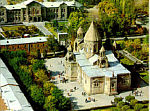
This tour refers to sites by their corresponding numbers on the CATHEDRAL COMPLEX MAP. Map points are written like: (X).
East Courtyard
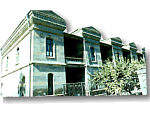
Central Courtyard
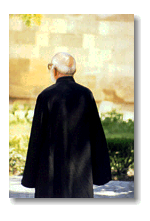
The Cathedral is covered in detail beginning with the next section.
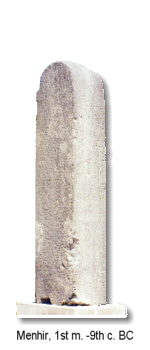
Residence Quarter museums are covered in detail in following sections.
